
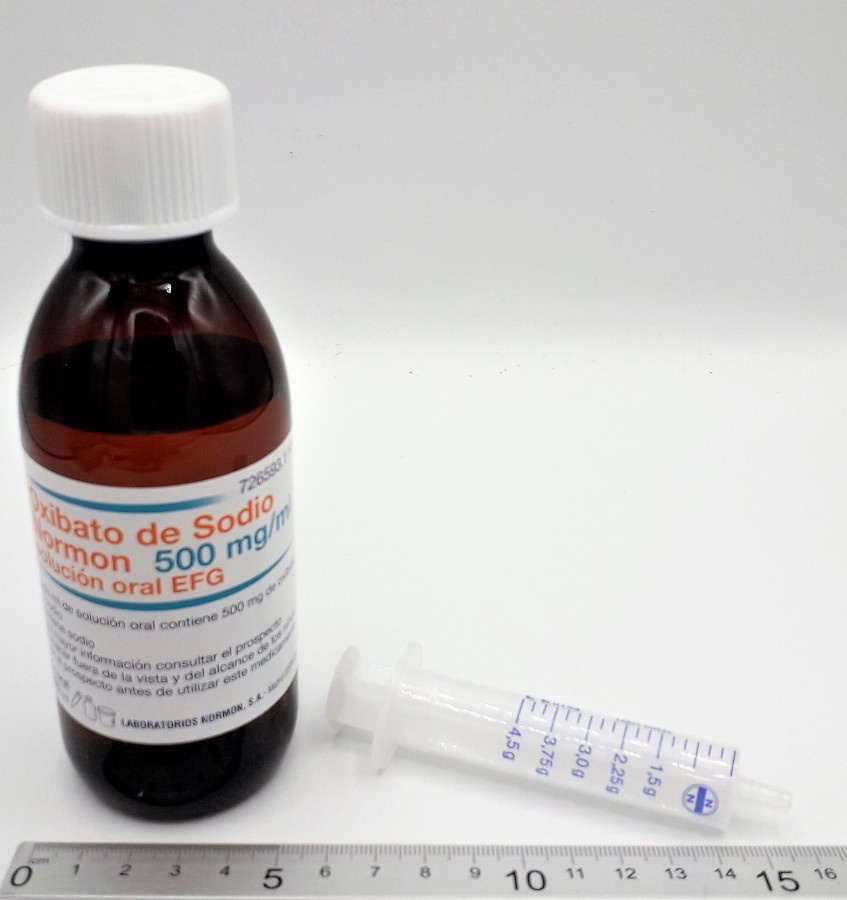
SODIUM OXIBATE ZENTIVA 500 MG/ML ORAL SOLUTION

Ask a doctor about a prescription for SODIUM OXIBATE ZENTIVA 500 MG/ML ORAL SOLUTION

How to use SODIUM OXIBATE ZENTIVA 500 MG/ML ORAL SOLUTION
Introduction
Package Leaflet: Information for the Patient
Sodium OxybateZentiva500 mg/ml Oral Solution EFG
sodium oxybate
Read all of this leaflet carefully before you start taking this medicine because it contains important information for you.
- Keep this leaflet, you may need to read it again.
- If you have any further questions, ask your doctor or pharmacist.
- This medicine has been prescribed for you only. Do not pass it on to others. It may harm them, even if their signs of illness are the same as yours.
- If you get any side effects, talk to your doctor or pharmacist. This includes any possible side effects not listed in this leaflet. See section 4.
Contents of the pack
- What Sodium Oxybate Zentiva is and what it is used for
- What you need to know before you take Sodium Oxybate Zentiva
- How to take Sodium Oxybate Zentiva
- Possible side effects
- Storing Sodium Oxybate Zentiva
- Contents of the pack and other information
1. What Sodium Oxybate Zentiva is and what it is used for
This medicine contains the active substance sodium oxybate. Sodium oxybate acts by consolidating nocturnal sleep, although its exact mechanism of action is not known.
Sodium oxybate is used to treat narcolepsy with cataplexy in adults, adolescents, and children from 7 years of age.
Narcolepsy is a sleep disorder that can include sleep attacks during the hours when you are normally awake, as well as cataplexy, sleep paralysis, hallucinations, and insomnia. Cataplexy is the sudden onset of muscle weakness or paralysis without loss of consciousness, in response to a sudden emotional reaction such as anger, fear, joy, laughter, or surprise.
2. What you need to know before you take Sodium Oxybate Zentiva
Do not take sodium oxybate
- if you are allergic to sodium oxybate or any of the other ingredients of this medicine (listed in section 6);
- if you have a deficiency of succinic semialdehyde dehydrogenase (a rare metabolic disorder);
- if you suffer from severe depression;
- if you are receiving treatment with opioid or barbiturate medicines.
Warnings and precautions
Consult your doctor or pharmacist before starting to take Sodium Oxybate Zentiva.
- if you have respiratory or pulmonary problems (and especially if you are obese), as sodium oxybate has the potential to cause breathing difficulties;
- if you have or have had depression, suicidal thoughts, anxiety, psychosis (a mental disorder that can involve hallucinations, incoherent speech, or disorganized and agitated behavior) or bipolar disorder;
- if you suffer from heart failure, high blood pressure, liver or kidney problems, you may need to have your dose adjusted;
- if you have previously abused medicines;
- if you suffer from epilepsy, as the use of sodium oxybate is not recommended in this disease;
- if you suffer from porphyria (a rare metabolic disorder).
If you have any of these problems, inform your doctor before taking Sodium Oxybate Zentiva.
If, while taking sodium oxybate, you experience nocturnal enuresis and incontinence (both urinary and fecal), confusion, hallucinations, sleepwalking episodes, or abnormal thinking, you must immediately inform your doctor. Although these effects are rare, if they occur, they are usually mild to moderate in nature.
In elderly patients, the doctor will carefully monitor their progress to check if sodium oxybate produces the desired effects.
Sodium oxybate has a well-known potential for abuse. There have been cases of dependence after illicit use of sodium oxybate.
Your doctor will ask you if you have consumed any drugs before starting to take sodium oxybate and while you are taking this medicine.
Children and adolescents
Sodium Oxybate Zentiva can be taken by adolescents and children from 7 years of age who weigh more than 15 kg.
Sodium Oxybate Zentiva must not be taken by children under 7 years of age or who weigh less than 15 kg.
If you are a child or adolescent, your doctor will regularly check your body weight.
While the doctor is adjusting the dose, which can take several weeks, parents/caregivers must carefully monitor the child's breathing during the first 2 hours after taking sodium oxybate to assess if there is any anomaly in breathing; for example, interruption of breathing during short periods while sleeping, noisy breathing, and a bluish color in the lips and face. If breathing anomalies are observed, medical assistance should be sought and the doctor should be informed as soon as possible. If any anomaly is observed after the first dose, the second dose should not be administered. If no anomaly is observed, the second dose can be administered. The second dose should not be administered before 2.5 hours or after 4 hours after the administration of the first dose.
If you have had or are having unpleasant feelings, especially if you feel very sad or have lost interest in life, it is important that you inform your doctor or caregiver.
Other medicines and Sodium Oxybate Zentiva
Tell your doctor or pharmacist if you are using, have recently used, or might use any other medicines.
In particular, Sodium Oxybate Zentiva must not be used with medicines that induce sleep and medicines that reduce the activity of the Central Nervous System (the Central Nervous System is the part of the body composed of the brain and spinal cord):
You must also inform your doctor or pharmacist if you are using any of the following types of medicines:
- medicines that increase the activity of the central nervous system
- antidepressants
- medicines that can be metabolized in a similar way by the body (e.g., valproate, phenytoin, or ethosuximide, which are used to treat epileptic seizures)
- topiramate (used to treat epilepsy)
If you are taking valproate, your daily dose of Sodium Oxybate Zentiva will need to be adjusted (see section 3) as it may interact with valproate.
Taking Sodium Oxybate Zentiva with food, drinks, and alcohol
You must not drink alcohol while taking sodium oxybate, as its effects may be increased.
Pregnancy and breastfeeding
If you are pregnant or breastfeeding, think you may be pregnant, or are planning to have a baby, ask your doctor or pharmacist for advice before taking this medicine.
There have been very few women who have taken sodium oxybate during pregnancy, and some of them have had miscarriages. The risk of taking sodium oxybate during pregnancy is not known, so its use is not recommended in pregnant women or women who are trying to become pregnant.
Patients taking sodium oxybate must stop breastfeeding, as sodium oxybate passes into breast milk. Changes in sleep have been observed in breastfed infants of exposed mothers.
Driving and using machines
Sodium oxybate can affect you if you drive or use machines. Do not drive, do not use heavy machinery, or do not perform any activity that may be hazardous or that requires mental alertness, for at least 6 hours after taking sodium oxybate. When you first start taking sodium oxybate and until you know if it makes you sleepy the next day, be extra careful when driving, operating heavy machinery, or doing any other activity that could be dangerous or requires complete mental alertness.
In pediatric patients, doctors, parents, or caregivers are warned that the waiting time to perform activities that require a state of mental alertness, motor coordination, or activities that may have a physical risk may be more than 6 hours, depending on individual sensitivity.
Sodium oxybate contains sodium
Since sodium oxybate contains sodium (which is found in table salt), you need to monitor the amount of salt you ingest, as it may affect you if you have previously had problems with high blood pressure, heart problems, or kidney problems. If you take two doses of sodium oxybate of 2.25 g each every night, you will be ingesting 0.82 g of sodium, or if you take two doses of 4.5 g of sodium oxybate every night, you will be ingesting 1.6 g of sodium. Ask your doctor for advice, as you may need to moderate your salt intake.
This medicine contains 0.41 g of sodium (the main component of table salt/cooking salt) in each 2.25 g dose. This is equivalent to 20% of the maximum recommended daily intake of sodium for an adult.
Consult your doctor or pharmacist if you need to take this medicine daily for a prolonged period, especially if you have been advised to follow a low-salt (sodium) diet.
3. How to take Sodium Oxybate Zentiva
Follow the instructions for administration of this medicine exactly as prescribed by your doctor or pharmacist. If you are in doubt, consult your doctor or pharmacist again.
It is important that you only use the syringe included in the box when preparing the doses of Sodium Oxybate Zentiva. The sodium oxybate syringe has two different measurement scales: one scale may be more useful for you than the other, depending on the dose your doctor has prescribed. When looking at each scale, you will see which one has the exact mark for your dose. There are other oral solutions with sodium oxybate, but each one may have a different way of administration. Read carefully how to use this medicine and consult your doctor or pharmacist if you are not sure.
Adults: taking Sodium Oxybate Zentiva alone
- The recommended initial dose for adults is 4.5 g each day, divided into two separate doses of 2.25 g.
- Your doctor may gradually increase your dose up to a maximum of 9 g each day, divided into two separate doses of 4.5 g.
- Take sodium oxybate orally twice each night:
- Take the first dose when going to bed and the second dose 2½ to 4 hours later. You may need an alarm clock to make sure you wake up to take the second dose.
- Food reduces the amount of sodium oxybate absorbed by your body. Therefore, it is best to take sodium oxybate always at a certain time, 2 or 3 hours after meals.
- Prepare both doses before going to bed.
- Take the doses within 24 hours after preparation.
Adolescents and children from 7 years who weigh 15 kg or more: taking Sodium Oxybate Zentiva alone
For children from 7 years who weigh 15 kg or more, the doctor will calculate the suitable dose based on body weight.
The doctor will calculate the suitable dose for you. Do not exceed the dose that has been prescribed for you.
Adults: taking Sodium Oxybate Zentiva with valproate
If you are taking valproate with sodium oxybate, your doctor will adjust the dose of sodium oxybate.
- The recommended initial dose of this medicine, when used with valproate, is 3.6 g each day, administered in two separate doses of 1.8 g.
- Take the first dose when going to bed and the second dose 2½ to 4 hours later.
Adolescents and children from 7 years who weigh 15 kg or more: taking Sodium Oxybate Zentiva with valproate
If you are taking valproate with sodium oxybate, your doctor will adjust the dose of sodium oxybate.
Liver or kidney problems
If you have kidney problems, you should follow the dietary recommendations to reduce sodium intake (salt). If you have liver problems, the initial dose should be reduced by half. Your doctor may gradually increase your dose.
Instructions for diluting Sodium Oxybate Zentiva
The following instructions explain how to prepare sodium oxybate. Read the instructions carefully and follow them step by step. Do not allow children to prepare sodium oxybate.
To help you, the sodium oxybate package contains 1 bottle of medicine, a graduated syringe (with two different scales), an adapter, and two dosing cups with child-resistant caps.
- Remove the cap from the bottle by pressing down and twisting counterclockwise (to the left). After removing the cap, place the bottle upright on a table. You must remove the plastic seal from the mouth of the bottle before using it for the first time. While keeping the bottle upright, insert the adapter into the neck of the bottle by pressing. This should only be done the first time the bottle is opened. The adapter can be left on the bottle for subsequent uses.
- Push the plunger of the syringe down to the bottom of the syringe cylinder (toward the tip) to eliminate excess air. Then, insert the tip of the graduated syringe into the center of the bottle opening and press firmly (See Figure 1).
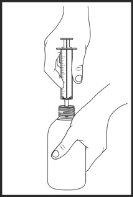
Figure 1
- While holding the bottle and syringe with one hand, turn the bottle over and extract the prescribed dose (following the 0.20 g or 0.25 g graduations on the syringe body) with the other hand by pulling the plunger. NOTE: The medicine will not flow into the syringe unless you keep the bottle upright (See Figure 2).
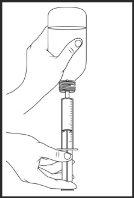
Figure 2
- Place the bottle upright. Remove the syringe from the center of the bottle opening. Empty the medicine from the syringe into one of the provided dosing cups by pushing the plunger (See Figure 3). Repeat this step for the second dosing cup. Then, add approximately 60 ml of water to each dosing cup (60 ml is approximately 4 tablespoons).
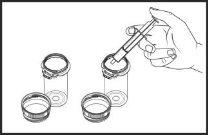
Figure 3
- Put the caps on the dosing cups and turn each cap clockwise (to the right) until you feel the click and close it in the child-resistant position (See Figure 4). Rinse the syringe with water.
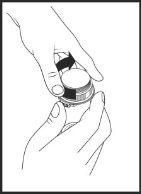
Figure 4
- Just before going to bed:
- Adult patients should place their second dose near their bed just before going to bed.
- Parents or caregivers of adolescents and children from 7 years should not leave the second dose near the child's bed or within their reach.
- You may need an alarm clock to make sure you wake up to take your second dose, no earlier than 2.5 hours and no later than 4 hours after your first dose.
Then:
- Remove the cap from the first dosing cup by pressing the child-resistant cap and turning it counterclockwise (to the left).
- Drink the first dose sitting in bed, cover the cup, and then lie down immediately.
- In the case of children who sleep more than 8 hours but less than 12, the first dose can be administered after the child has slept for 1 to 2 hours.
- When you wake up or wake the child between 2.5 and 4 hours later, remove the cap from the second dosing cup. Sitting in bed, drink the second dose just before lying down again to continue sleeping. Cover the second cup.
If you think the effect of sodium oxybate is too strong or too weak, tell your doctor or pharmacist.
If you take more Sodium Oxybate Zentiva than you should
The symptoms of sodium oxybate overdose can include agitation, confusion, altered mobility, breathing difficulties, blurred vision, excessive sweating, headache, vomiting, decreased consciousness that can lead to coma and epileptic seizure, excessive thirst, muscle cramps, and weakness. If you take more sodium oxybate than you should, or take it by accident, seek immediate emergency medical help. You should take the medicine box with you, even if it is empty.
In case of overdose or accidental ingestion, consult your doctor or pharmacist immediately or call the Toxicology Information Service, phone: 91 562 04 20, indicating the medicine and the amount ingested.
If you forget to take Sodium Oxybate Zentiva
If you forget to take the first dose, take it as soon as you remember and continue with the procedure described previously. If you miss the second dose, skip that dose and do not take sodium oxybate again until the next night. Do not take a double dose to make up for the missed doses.
If you are not sure if you have taken Sodium Oxybate Zentiva
In case of doubt about the administration of a dose, do not administer the dose again to reduce the risk of overdose.
If you stop taking Sodium Oxybate Zentiva
You should continue taking sodium oxybate while your doctor continues to prescribe it for you. If you stop the medication, cataplexy attacks may return, and you may experience insomnia, headache, anxiety, dizziness, sleep disorders, somnolence, hallucinations, and abnormal thinking.
If you stop treatment with sodium oxybate for more than 14 days, you should consult your doctor, as you may need to start treatment with sodium oxybate again from a lower dose.
If you have any other questions about the use of this medicine, ask your doctor or pharmacist.
4. Possible Adverse Effects
Like all medicines, this medicine can cause adverse effects, although not all people suffer from them. These are often of mild to moderate intensity.
Adults: most frequent adverse effects observed in clinical studies(occurring in 10% to 20% of patients):
- dizziness
- nausea
- headache.
If you experience any of these adverse effects, inform your doctor immediately.
Children and adolescents: most frequent adverse effects observed in a clinical study:
- bedwetting (18.3%)
- nausea (12.5%)
- vomiting (8.7%)
- weight loss (8.7%)
- decreased appetite (6.7%)
- headache (5.8%)
- dizziness (5.8%)
- suicidal thoughts (1%)
- feeling mentally unwell (loss of contact with reality) (1%)
If you experience any of these adverse effects, inform your doctor immediately.
The adverse effects in adults and children are the same. If you experience any of these adverse effects, inform your doctor immediately:
Very common: may affect more than 1 in 10 people
- nausea
- dizziness
- headache.
Common: may affect up to 1 in 10 people
- sleep problems such as insomnia, abnormal dreams, sleep paralysis, somnolence, nightmares, sleepwalking, bedwetting, excessive daytime sleepiness, difficulty falling asleep in the middle of the night
- feeling of intoxication, tremors, confusion or disorientation, blurred vision, balance disorder, falls, feeling of "dizziness" (vertigo)
- feeling heartbeats, increased blood pressure, shortness of breath
- vomiting, stomach pain, diarrhea
- anorexia, decreased appetite, weight loss
- weakness, fatigue, sedation
- sweating
- depression
- muscle cramps, swelling
- joint pain, back pain
- attention disorder, sensitivity disorder especially to touch, abnormal touch sensation, abnormal taste
- anxiety, nervousness
- urinary incontinence
- snoring, nasal congestion
- rash
- breast inflammation, nasal and throat inflammation
Uncommon: may affect up to 1 in 100 people
- Psychosis (a mental disorder that can produce hallucinations, incoherent speech, or disorganized or agitated behavior)
- paranoia, abnormal thinking, hallucinations, agitation, attempted suicide
- difficulty falling asleep, restless legs
- memory loss
- myoclonus (involuntary muscle contractions)
- involuntary bowel movements
- hypersensitivity
Frequency not known: cannot be estimated from the available data
- seizure
- decrease in depth or frequency of breathing, short cessation of breathing during sleep
- urticaria
- suicidal thoughts, delirium, thoughts of committing violent acts (including harming others)
- irritability, aggression
- euphoric mood
- panic attack
- mania/bipolar disorder
- dry mouth, dehydration
- facial swelling (angioedema)
- bruxism (bruxism and jaw clenching)
- pollakiuria/urinary urgency (increased need to urinate)
- tinnitus (noise in the ears, such as ringing or buzzing)
- sleep-related eating disorders
- increased appetite
- loss of consciousness
- dykinesia (e.g., abnormal and uncontrolled movements of the limbs)
- dandruff
- increased sexual desire
- nocturia (excessive urination at night)
- feeling of suffocation
Reporting of Adverse Effects
If you experience any type of adverse effect, consult your doctor, pharmacist, or nurse, even if it is a possible adverse effect that does not appear in this prospectus. You can also report them directly through the Spanish Pharmacovigilance System for Human Use Medicines: https://www.notificaram.es. By reporting adverse effects, you can contribute to providing more information on the safety of this medicine.
5. Storage of Sodium Oxybate Zentiva
Keep this medicine out of sight and reach of children.
Do not use this medicine after the expiration date that appears on the bottle after (EXP). The expiration date is the last day of the month indicated.
This medicine does not require special storage conditions.
After dilution in the dosing cups, the preparation should be used within 24 hours.
Once the sodium oxybate bottle is opened, any unused content must be discarded after 45 days.
Medicines should not be thrown away through wastewater or household waste. Deposit the packaging and medicines you no longer need at the SIGRE point in the pharmacy. In case of doubt, ask your pharmacist how to dispose of the packaging and medicines you no longer need. This way, you will help protect the environment.
6. Package Contents and Additional Information
Composition of Sodium Oxybate Zentiva
The active ingredient is sodium oxybate. Each ml contains 500 mg of sodium oxybate.
The other components are purified water, malic acid, and sodium hydroxide to adjust the pH.
Appearance of the Product and Package Contents
Sodium oxybate is presented in a 200 ml amber PET bottle containing 180 ml of oral solution and closed with a white transparent plastic screw cap and a child-resistant closure, composed of HDPE/polypropylene, with a white expanded polyethylene seal disc.
Each package contains a bottle, a measuring device (a 4.5 g capacity transparent polypropylene syringe with a white PE piston) with graduations of 0.25 g, a syringe adapter made of transparent LDPE, two 90 ml capacity orange polypropylene dosing cups, and two child-resistant closures made of white HDPE.
A comma is used as a decimal separator in the syringe graduation.
Marketing Authorization Holder and Manufacturer
Marketing Authorization Holder
Zentiva k.s.,
U kabelovny 130,
Dolní Mecholupy,
102 37 Prague 10
Czech Republic
Manufacturer
Labomed Pharmaceutical Company S.A.
84 Ioannou Metaxa street,
Koropi, Attica 19441,
Greece
or
ARISTO PHARMA GMBH
Wallenroder Strasse 8-10
Berlin-13435 Germany
You can request more information about this medicine by contacting the local representative of the marketing authorization holder: Zentiva Spain S.L.U.
Avenida de Europa, 19, Edificio 3, Planta 1.
28224 Pozuelo de Alarcón, Madrid
Spain
Your doctor should have given you a package of information about Sodium Oxybate Zentiva, which includes a leaflet on how to take the medicine, a patient information sheet with Frequently Asked Questions, and a patient alert card.
This medicine is authorized in the EEA member states with the following names:
Netherlands Natriumoxybaat Aristo 500mg/ml drank
Germany Natriumoxybat Aristo 500mg/ml Lösung zum Einnehmen
Spain Oxibato de sodio Zentiva 500mg/ml oral solution EFG
Italy Sodio Oxibato Aristo
United Kingdom Sodium Oxybate 500mg/ml Oral Solution
Date of the last revision of this prospectus:April 2021
Detailed information about this medicine is available on the website of the Spanish Agency for Medicines and Health Products (AEMPS) http://www.aemps.gob.es/.
- Country of registration
- Active substance
- Prescription requiredYes
- Manufacturer
- This information is for reference only and does not constitute medical advice. Always consult a licensed doctor before taking any medication. Oladoctor is not responsible for medical decisions based on this content.
- Alternatives to SODIUM OXIBATE ZENTIVA 500 MG/ML ORAL SOLUTIONDosage form: ORAL SOLUTION/SUSPENSION, 300 mg/mlActive substance: sodium oxybateManufacturer: Accord Healthcare S.L.U.Prescription requiredDosage form: ORAL SOLUTION/SUSPENSION, 500 mg/mlActive substance: sodium oxybateManufacturer: Laboratorios Normon S.A.Prescription requiredDosage form: ORAL SOLUTION/SUSPENSION, 500 mg/mlActive substance: sodium oxybateManufacturer: Laboratorio Reig Jofre, S.A.Prescription required
Alternatives to SODIUM OXIBATE ZENTIVA 500 MG/ML ORAL SOLUTION in other countries
The best alternatives with the same active ingredient and therapeutic effect.
Alternative to SODIUM OXIBATE ZENTIVA 500 MG/ML ORAL SOLUTION in Poland
Alternative to SODIUM OXIBATE ZENTIVA 500 MG/ML ORAL SOLUTION in Ukraine
Online doctors for SODIUM OXIBATE ZENTIVA 500 MG/ML ORAL SOLUTION
Discuss dosage, side effects, interactions, contraindications, and prescription renewal for SODIUM OXIBATE ZENTIVA 500 MG/ML ORAL SOLUTION – subject to medical assessment and local rules.












